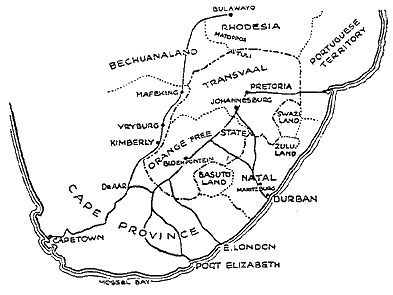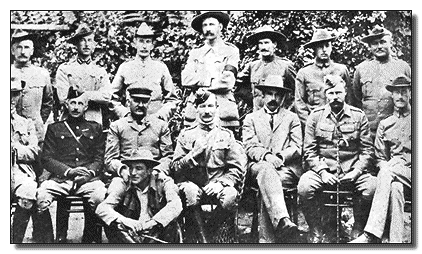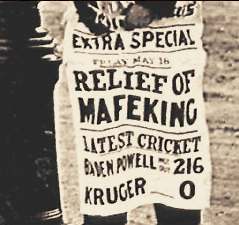Siege of Mafeking
The Siege of Mafeking was the most famous British action in the Second Boer War. It took place at the town of Mafeking (now Mafikeng) in South Africa over a period of 217 days, from October 1899 to May 1900, and turned Robert Baden-Powell into a national hero. The lifting of the Siege of Mafeking was a decisive victory for the British and a crushing defeat for the Boers.
Índice
Prelude[editar]
Shortly before the outbreak of the Second Boer War in 1899, Lord Wolseley, Commander-in-Chief of the British Army, who had failed to persuade the British government to send troops to the region, instead sent Colonel Baden-Powell, accompanied by a handful of officers, to the Cape Colony to raise two Regiments of Mounted Rifles from Rhodesia (now Zimbabwe). The aims were to resist the expected Boer invasion of the Natal Colony (now KwaZulu-Natal Province), draw the Boers away from the coasts to facilitate the landing of British troops, and, through a demonstrable British presence, deter the local tribes from siding with the Boers.
Like the British government, the local politicians feared that increased military activity might provoke a Boer attack, so Baden-Powell found himself having to obtain many of his own stores, organise his own transport and recruit in secret. With barely trained forces and aware of the Boer's greatly superior numbers, commando tactics and the failure of the earlier Jameson Raid, Baden-Powell decided that the best course of tying down Boer troops would be through defence rather than attack. Consequently he chose to hold the town of Mafeking due to its location - both near the border and on the railway between Bulawayo and Kimberley, Kimberley - and because of its status as a local administrative centre, which he also found to have good stocks of food.
The Mafeking forces comprised the Protectorate Regiment of around 500 men, around 300 from the Bechuanaland Rifles and the Cape Police, and a further 300 comprising men from the town. A cadet corps of boys aged 12 to 15, later to be one of the inspirations for the Scouting movement, was also formed to act as messengers and orderlies, so releasing men to fight and bringing the total engaged in the military effort to around 2000.
The siege[editar]
Work to build defences around the six mile perimeter of Mafeking started on September 19 1899, and the town would eventually be equipped with an extensive network of trenches and gun emplacements. President Paul Kruger of the Boer Transvaal Republic declared war on October 12 1899. Under the orders of General Cronje the Mafeking railway and telegraph lines were cut the same day, and the town began to be besieged from October 13. Mafeking was first shelled on the October 16 after Baden-Powell ignored Cronje's 9 o'clock deadline to surrender.
Although wholly outnumbered by over 8,000 Boer troops, the garrison withstood the siege for 217 days, defying the predictions of the politicians on both sides. Much of this was attributable to some of the cunning military deceptions instituted by Baden-Powell. Fake landmines were laid around the town in view of the Boers and their spies within the town, and his soldiers were ordered to simulate avoiding barbed wire (non-existent) when moving between trenches; guns and a searchlight (improvised from an acetylene lamp and biscuit tin) were moved around the town to increase their apparent number. A howitzer was built in Mafeking's railway workshops, and even an old cannon was pressed into service. The morale of the civilian population was also given attention, and Sunday ceasefires were negotiated so that sports, competitions and theatrical performances could be held.
Having decided that the town was too heavily defended to take, on November 19 4,000 Boers were redeployed elsewhere, although the siege remained and shelling of Mafeking continued. Aware of the approaching British relief columns, the Boers launched a final major attack on the evening of May 11, succeeded in breaching the perimeter defences and setting light to some of the town, but were finally beaten back.
Extract from Diary (Trooper William Robertson Fuller[editar]
1899[editar]
October 13th Boers crossed the border and blew up two trucks of dynamite about five miles out, which were taken out of Mafeking Station for safety.
October 14th Boers attacked off the North East Side of town about 7 am and after about 3½ hours hard fighting we retired. Boer force estimated about 800 strong while ours was only about 60. Our loss 4 killed and 16 wounded. Boer loss not known.
October 15th Everything quiet. Boers don’t intend to break the Sabbath. Everybody busy digging trenches.
October 16th Cronje sent in a message saying we must surrender by 9 am otherwise he would shell town. BP sent back saying he wouldn’t surrender and to shell as soon as he likes. About 10.30 am shelling commences. No damage done, only seven pounders in action.
October 17th Boers sent in again, asking us to surrender to save further bloodshed. Reply, "Ikona". Bloodshed only one dog and two fowls killed.
October 23rd A devil of an explosion heard outside trenches of which we found out to be Boer 95 pounder, which they have placed off South West of town about three miles out. Everybody in dugouts. Short was hit with a piece of first shot and broke his leg.
October 27th D Squadron, 65 strong under Captain Fitz made an attack on Boer trench East of town. Managed to get at them with bayonets. Our loss 6 killed 9 wounded. Enemy’s not known, but we heard afterwards it was 80.
October 28th Boers sent in trolley of dynamite towards town, but fortunately for us it exploded about 1 mile out of town. I presume the trolley went too slow for the fuse.
October 29th Sargent W H Bolton of A Squadron deserted, supposed to have gone over to the Boers. A reward is out to the amount of £50 to the man that discovers him dead or alive. Have since heard that he wandered to the Dutch while drunk.
October 31st Boers attacked Cannon Kopje and were repulsed with a loss of about 100. Our loss, 8 killed: two officers, two SMo, 4 men and 7 wounded.
November 7th Boers attacked PU defences and were repulsed. Our casualties, 4 wounded. Enemy’s not known.
December 21st About 200 men paraded at 10 pm at the Budgs. All served out with India Rubber shoes. Rumour is to attack Big Ben on South East Heights. After going through a few manoeuvres, were marched back to trenches. Enemy supposed to have got wind of it.
December 26th C and D Squadron under Major Godley attacked Boer Fort (Game Tree) North of town. Our strength 114 men. We were repulsed losing 3 officers, 23 men and 22 wounded. A few have died of wounds since. Captain Fitz was wounded.
1900[editar]
January 26th A Big Ben fired into Women’s Laager. No casualties. BP sent message saying if they started shelling women again he would place all suspected Dutch spies in an enclosure in the Laager. Therefore, they would be killing their own friends.
February 2nd Boers shell Cannon Kopje again. Our loss 1 killed and 2 wounded. Bread rations cut down to half and this is the saddest news up to date.
February 10th Bread rations still the same.
February 11th Man named Dall killed by 95 pounder. The shell hit him full on the stomach and took half his body away.
February 12th Notices posted in town that Seige is likely to last until end of May.
February 15th Big Ben moved quarters. Gone from East to West Side of town. Fired 12 shots; two at L Fort Store, two at Laager, two at Magazine, four in Native Staadt, two at Stables. No damage done, fortunately.
February 17th Whilst about 20 of us drawing rations, a Big Ben landed about 25 yards from us. No damage. Range about 3½ miles.
February 22nd Man named Miller of B Squadron was blown to pieces by 95 pound shell whilst opening it. His pal just escaped having taken one back which he had previously opened. Big Ben shifted back to old position East of town.
February 25th We are making our own powder and casting shells. Both a great success. Census of cattle taken: 20 horses, 35 mules, 470 oxen, 61 calves, 500 goats and sheep. Two men from Town Guard deserted to Boer lines. Names Rudolf Reck and John Evert. They were both suspected spies and were only let out of prison yesterday.
February 26th Cast gun to fire 16 pounds shell. Fired one shot when it was seen alterations must be made. We are now eating horse flesh. Have had doubts about meat for some days. Always thought it wasn’t beef. Not bad, but tough. General complaint, not enough of it. We eat anything in these times.
February 27th About 800 Natives left here for Kanye about 60 miles North. They are leaving town on account of scarcity of food. Boers fired on them killing a few, also a good number have returned. Elkington of CPD2 struck with 5 pounds shell in face. Face is disfigured. Will live but will be blind for life. Soup kitchens opened to feed Natives. Dogs not licensed are to be destroyed. Looks suspicious.
March 2nd About 400 men women and children (Natives) went out with white flag on the Northern Road. Boers went out and met them and asked them where they were going. They said they were going to Kanye as they were starving. Boers refused to let them pass and ordered them back and when they got about three hundred yards from the fort they opened fire on them, killing many, among them several women and children. BP sent out white flag saying if they didn’t allow the Natives to pass through to Kanye to their homes and also withdraw Natives from their trenches, he would set Linchwe, Bathwane and Sabele, (numbering in all about 100 000 men) on them, these Natives having been kept in check by us. Our gun, now altered, appears to be a success. Can travel at a pretty good range.
March 5th Boers shell our Cape boys out of advance trench in brick fields and during night make another trench to one of our supporting trenches. D squad, CP&B Rifles retake trench. Enemy now within 40 yards distance of our advance trench. We are now throwing hand grenades into their trench. Boers doing also to us.
March 6th Most of our men are now buying starch and eating it. A la Mazina! Not bad at all.
March 10th Trooper Sydney Webb D2 Police shot through the head whilst on sentry in the brick fields. A chap that was very well liked by everybody.
March 13th Had some Donkey meat for dinner today and found it to be beautiful and tender. Better than horse meat.
March 21st Trooper Tottie Hay of A squadron deserted over to the Boer lines. He was doing 7 days field imprisonment at the time. There is a reward of £50 out for the man who finds him dead or alive.
March 24th Boers evacuated the brick fields today. Cause unknown.
March 27th Boers took a fit into their heads and shelled very heavily today, sending into town about 200 shells.
March 31st A body of Plumer’s Scouts engaged the Boers out at Oaklands. Our loss pretty heavy. Boers unknown. Everybody thought the Relief was at hand. Our mounted men have parades every day, getting ready for no one knows.
April 4th Had sowen for breakfast. It is fermented oats, sour like Kaffir beer. Not so bad. Find it fills up for an hour or so, but my belief is it turns to water.
April 11th Shelling pretty heavy today. No damage to speak of. Only a few horses and donkeys killed. Bread reduced to 6 ounces and a quart of sowen dished out to us in place of the 2 ounces of bead cut off. Am damn sick of it!
April 14th An attempt was made to bring in 100 hundred fat cattle last night. They were driven by 30 boys, but failed in the attempt. 23 Boys killed and all cattle captured by the Boers. Just as usual, Live and Learn. Troopers Maloy and Hassel were killed today by 12½ pound high velocity gun.
April 29th Had horse meat polonies for rations today. Find it eatible, but damn tough. One man named Day fried his in Day and Martin’s Dubbin. He said it wasn’t bad. I fried mine in cocoa-nut oil. Not bad at all. Eloff sent into BP today and asked him if he would play him a game of cricket. BP sent back saying we were 200 not out already and they have tried every bowler but don’t seem to get us out.
May 6th Dutch made a charge on our horses today. They managed to get away with 23 and 9 mules and also shot one of the horse guards, a chap named Francis, BSAP. This is the third brother been killed.
May 7th 6 Prime fat slaughter oxen arrived last night from Colonel Plumer.
May 12th The Boers under Eloff, to the number of 700, rushed up the bed of the river past our outposts. Got into the Staadt, set fire to part of it. From there they rushed the BSA Fort, capturing 4 officers and 13 men. (Colonel Hore and Captain Singleton among the captured. We were turned out to reinforce a small fort down at the river, but were too late to do any good, so we retired and while retiring were under a perfect hail of bullets, but got down to the town without any casualties. From there we went down and raided the BSA Fort. The CP Town Guard relieved us and from thence we went down to the Staadt and captured it and wounded three. I escorted prisoners into town. The same evening the lot in the BSA Fort surrendered to us, but a lot rushed through our lines. We have 126 prisoners and have picked up 50 Boers dead and the Lord only knows how many the Kaffirs have killed and buried away. Our loss, 3 killed.The Jailor was also killed today by a shell.
May 16th 5.30 pm. Artillery firing heard today North West of town. It is believed to be our Relief at hand, about 6 miles away. 8.00 pm. An officer and 8 men just arrived from outside. Relief Column arrived at last, after 7 months and 5 days weary waiting. They engaged Boers at 2 pm and inflicted defeat on them.
May 17th
2.00 am. The Relief Column arrived in town about 2 o’clock, numbering 1200 from the South and 900 from the North. Great excitement prevails all our garrison and town.
9 am. RHA with Pom Poms moved towards East Side of town and started shelling the trenches. They stayed about half an hour and gracefully retired to the Laager, and then we started shelling the Laager, of which the Boers promptly evacuated and we captured.
We captured a lot of rifles and ammunition in trenches and the Laager had an awful lot of provisions, including meal flour, coffee. sugar, tea, pipes, tobacco, cigarettes, sporting guns, saddles, bridles, boots, biscuits, butter, potatoes, oatmeal, onions, horse shoes, biltong, eggs, whiskey, beer, dop, clothing, donkeys and wagons and also a lot of their sick they left behind in their hospital, including some of our wounded which were captured at the time of Colonel Plumer’s defeat, including Captain Maclarene. We also captured their 5 pounder in one trench
The relief of Mafeking[editar]
The siege was finally lifted on May 17 1900, when British forces commanded by Colonel B T Mahon of the army of Lord Roberts relieved the town after fighting their way in. Among the relief forces was one of Baden-Powell's brothers, Major Baden Fletcher Smyth Baden-Powell.
Impact and aftermath[editar]
Until reinforcements landed in February 1900, the war was going poorly for the British. The resistance to the siege was one of the positive highlights, and it and the eventual relief of the town excited the liveliest sympathy in Britain. There were immense celebrations in the country at the news of its relief (briefly creating the verb to maffick, meaning to celebrate both extravagantly and publicly). "Maffick" was a back-formation from Mafeking, a place-name that was treated humorously as a gerund or participle.
Promoted to the youngest Major-General in the army, and awarded the CB, Baden-Powell was also treated as a hero when he finally returned to Britain in 1903.
Three Victoria Crosses were awarded as a result of acts of heroism during the siege, to Sergeant Horace Martineau and Trooper Horace Ramsden for acts during an attack on the Boer Game Tree Fort, and to Captain Charles FitzClarence for Game Tree and two previous actions.
In September 1904 Lord Roberts unveiled an obelisk at Mafeking bearing the names of those who fell in defence of the town. In all, 212 people were killed during the siege, with over 600 wounded. Boer losses were significantly higher.
The best known impact of the siege is non-military. By establishing Baden-Powell as a celebrity in Britain, it enabled him to start the Scout movement a few years later, his fame contributing to its rapid initial growth.
External links[editar]
See also[editar]
- B.P.s tells the story - Extract from "Lessons from the Varsity of Life" Chapter 7 - Mission to South Africa
- B.P.s tells the story - Extract from "Lessons from the Varsity of Life" Chapter 7 - The South African War - Mafeking, Defense and Relief
Sources[editar]
USS Scout Project


